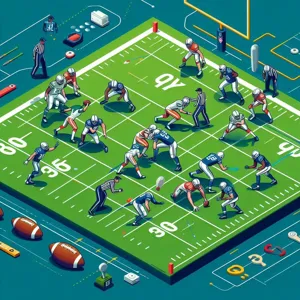Football is much more than just a game; it’s a complex dance of strategy, teamwork, and precise execution.
Each play is a carefully crafted plan that, when executed correctly, can turn the tide of a match and lead a team to victory. With the right understanding of different football plays and their optimal timing, players can master the field and elevate their game to new heights. In this comprehensive guide, we will delve into the intricacies of various offensive and defensive plays, exploring their unique purposes, formations, and the critical moments when they shine the brightest. Whether you’re a seasoned player looking to refine your skills or a passionate fan eager to deepen your understanding of the sport, this post will equip you with the knowledge to recognize the perfect play at the perfect time, ensuring you’re always one step ahead on the gridiron. get ready to unlock the secrets of the game and become a true master of football!
1. Introduction to Football Plays: Understanding the Basics

Football is a game of strategy, precision, and timing, where every play can be the difference between victory and defeat. At its core, understanding football plays is about grasping the fundamental concepts that dictate how teams operate on the field. Each play is a carefully crafted plan designed to exploit the weaknesses of the opposing defense or capitalize on the strengths of the offense.
In this section, we will delve into the essential components of football plays, including formations, routes, and roles of each position. A formation sets the stage, dictating how players are aligned before the snap, while routes define the paths receivers will take to create separation from defenders. Each player has a specific role, whether it’s the quarterback orchestrating the play, running backs executing precise handoffs, or wide receivers making those critical catches in tight coverage.
Timing is crucial; it’s not just about the execution of the play but also about knowing when to call it. Different situations—such as down and distance, score, and time remaining—will dictate which plays are most effective. For instance, a team might opt for a short, safe pass on third and short, while in a two-minute drill, they may favor deeper routes to conserve time.
As we explore the various types of football plays, you’ll discover how they work in unison to create a dynamic and unpredictable game. Whether you’re a player, coach, or just a passionate fan, mastering the basics of football plays will enhance your understanding of this exhilarating sport, allowing you to appreciate the intricate dance of strategy and athleticism that unfolds on the field.
2. Offensive Plays: Types and Strategies
When it comes to the heart of football, offensive plays are where the strategy truly shines. The ability to read the defense, adapt to the game situation, and execute flawlessly can mean the difference between a touchdown and a turnover. Here, we’ll explore various types of offensive plays and the strategies that underpin them, ensuring your team can effectively navigate the complexities of the game.
**1. Running Plays:** At the core of many offensive strategies are running plays, designed to exploit gaps in the defensive line. These plays can range from straightforward rushes to more intricate designs like sweeps and counters. The key to success with running plays lies in timing and execution—offensive linemen must create a wall of protection, while the running back must have the vision to find the smallest openings. The perfect moment to call a running play can often be when the defense is overcommitted to stopping the pass.
**2. Passing Plays:** Passing plays add a dynamic layer to the offense, allowing teams to stretch the field and exploit defensive weaknesses. These can be categorized into short, intermediate, and deep passes, each serving a distinct purpose. Short passes are ideal for quick gains and maintaining possession, while deep passes can be game-changers, setting the stage for explosive yardage. Timing is crucial here; a well-executed play-action can freeze linebackers and create space for receivers to break free.
**3. Play-Action Plays:** This strategy combines deception and timing to great effect. By faking a run, the quarterback can draw defenders in before quickly transitioning to a pass. The success of a play-action play hinges on the running game’s effectiveness earlier in the game, making it an excellent tactic for capitalizing on a defense that has committed to stopping the run.
**4. Screen Plays:** Often underutilized, screen plays can be incredibly effective in countering aggressive defenses. By allowing defenders to rush in, the offense can set up a quick pass to a running back or receiver behind the line of scrimmage. Timing is everything here; the quarterback must hold the ball just long enough for the defenders to commit, then release it to an awaiting playmaker who has potential blockers ahead.
**5. Option Plays:** These plays allow the quarterback to make split-second decisions based on the defensive alignment. Whether to hand the ball off, keep it themselves, or pitch it to a trailing back can create chaos for the defense, making it a high-reward option. Mastery of this play type requires an understanding of the defense’s movements and a strong rapport between the quarterback and the backs.
Understanding these offensive plays and their perfect timing can significantly elevate your football strategy. By adapting your approach based on the defense and the game situation, you can keep your opponents guessing and your own team advancing toward victory. Embrace the nuances of each play, and you’ll be on your way to mastering the field!
3. Defensive Plays: Key Techniques and Approaches

Defensive plays are the backbone of any effective football strategy, serving as the first line of resistance against opposing offenses. Mastering these techniques requires a deep understanding of the game, keen observation, and impeccable timing. At the heart of defensive plays lies the principle of positioning: defenders must anticipate the offense’s moves while maintaining their own alignment to thwart any advances.
One of the most fundamental techniques is the **tackle**, which can vary from a standard wrap-up to a more aggressive, shoulder-first approach. Timing is crucial here; a well-timed tackle can halt a runner in their tracks, while a mistimed attempt can lead to missed opportunities and big gains for the offense. Players often practice drills that focus on breaking down the runner’s movements, allowing them to react swiftly and decisively.
Another essential defensive strategy is the **blitz**, where a linebacker or defensive back rushes towards the quarterback in an attempt to disrupt the play. Timing the blitz is an art form; defenders must read the snap count and the quarterback’s posture to strike before the play can fully develop. A successful blitz can lead to a sack, an interception, or at the very least, a hurried throw that could result in a turnover.
**Zone coverage** is another critical approach, allowing defenders to cover specific areas of the field rather than individual players. This technique requires seamless communication and awareness among teammates, as defenders must shift according to the flow of the game. Timing in zone coverage hinges on understanding the offense’s patterns and being prepared to close gaps as the play unfolds.
Incorporating these defensive plays into your strategy not only strengthens your team’s overall performance but also cultivates a culture of discipline and teamwork. As you practice these techniques, remember that the key to mastering defensive plays lies in repetition and the ability to adapt to ever-changing game scenarios. With solid execution and perfect timing, your defense can become a formidable force on the field, keeping the opposing team at bay and setting the stage for your offense to shine.
4. Special Teams: The Importance of Kicking Plays
When it comes to football, the spotlight often shines on offensive and defensive plays, leaving special teams somewhat in the shadows. However, neglecting this crucial aspect of the game could be a costly mistake. Special teams play a pivotal role in determining field position, scoring opportunities, and ultimately, the outcome of a game. Understanding the various kicking plays and their perfect timing is essential for teams aiming to master every facet of the game.
Kicking plays encompass a range of strategies, including kickoffs, field goals, and extra point attempts. Each of these plays requires precise execution and keen awareness of timing. For instance, during a kickoff, the kicker must assess the wind conditions, the opposing team’s return strategies, and the ideal angle for the kick. A well-placed kickoff can limit the opponent’s return yardage, setting the tone for the ensuing defensive stand.
Field goal attempts, on the other hand, hinge on synchronization between the snapper, holder, and kicker. A fraction of a second can mean the difference between success and failure. The timing of the snap must align perfectly with the kicker’s approach to ensure the ball is kicked cleanly and accurately. Moreover, understanding the game situation—such as the score, time remaining, and yardage—is crucial when deciding whether to attempt a field goal or go for a fourth down conversion.
Extra point attempts, while often seen as routine, also require a keen sense of timing. Teams need to be ready to respond to any unexpected shifts, such as a defensive penalty or a sudden change in strategy from the opposing team.
By honing their special teams’ skills and understanding the intricacies of each kicking play, teams can turn what is often viewed as an afterthought into a formidable weapon on the field. Mastering special teams not only amplifies a team’s overall performance but also instills confidence in players, knowing they can rely on every aspect of their game to secure victory.
5. The Role of Timing in Football Success

Timing is the heartbeat of football, a crucial element that can make or break a play. Every successful football team knows that executing a play is not just about the right formation or the best athletes on the field; it’s about synchronizing movements to create a seamless flow of action. The perfect timing in football can mean the difference between a touchdown and a turnover, a defensive stop and a scoring drive.
When the quarterback drops back to pass, every second counts. He must gauge the coverage, anticipate the receiver’s route, and deliver the ball at just the right moment. If he throws too early, the receiver may not be in position to catch the ball; too late, and the defense has already closed in. This delicate balance is what separates an average quarterback from an elite one. Mastery of timing also applies to running backs who must hit the hole just as the offensive line creates a gap, or to wide receivers who need to break off their routes precisely as the quarterback releases the ball.
Defensively, timing is equally crucial. A well-timed blitz can catch the offense off guard, disrupting their rhythm and forcing mistakes. Defensive backs must have impeccable timing to jump routes and intercept passes, while linebackers need to read the play and react in an instant to stop a runner in his tracks.
Practicing timing through drills, scrimmages, and film study is essential for all players. By understanding when to accelerate, slow down, or change direction, players can enhance their effectiveness on the field. Coaches play a pivotal role in this process, helping athletes recognize the nuances of timing and how it influences each play’s success.
In football, timing is not just a skill; it’s an art form that, when mastered, propels teams to success and creates unforgettable moments on the field. The synergy of players moving as one, responding instinctively to the rhythm of the game, is what turns a simple play into a spectacular achievement.
6. Common Offensive Plays and Their Execution
When it comes to the gridiron, mastering common offensive plays is crucial for any team that aims to dominate the field. Each play has its own strengths and weaknesses, and understanding their execution can mean the difference between a successful drive and a costly turnover. Here, we’ll break down some of the most prevalent offensive plays, shedding light on the intricacies of their execution and the perfect timing to unleash them.
**1. The Slant Route**
A staple in any offensive playbook, the slant route is designed for quick passes to exploit gaps in the defense. Timing is everything here; the receiver must make a sharp cut towards the quarterback just as the ball is snapped. This play thrives on speed and precision, with the quarterback delivering the pass before the defensive backs can react. Ideal for short-yardage situations, it can quickly turn into a big gain when executed correctly.
**2. The Sweep**
The sweep play involves the running back running parallel to the line of scrimmage before turning upfield, often utilizing the speed of a wide receiver or tight end to block defenders. Timing is key as the offense must pull linemen in perfect synchrony to create an opening. The play is most effective when the defense is overcommitted to the inside, allowing the ball carrier to find space on the outside.
**3. The Play Action Pass**
A classic tactic to confuse defenses, the play action pass fakes a handoff to the running back, drawing in linebackers and safeties. The quarterback must sell the fake with convincing footwork, allowing time for receivers to find open space downfield. Timing is critical; the quarterback needs to hold the ball just long enough to draw in defenders, yet release it before pressure arrives, making this play a high-risk, high-reward option.
**4. The Screen Pass**
Designed to create a misdirection effect, the screen pass allows the defense to rush while the offensive line retreats to set up a wall for the running back or receiver. Timing is crucial as the quarterback must release the ball just after the defensive rush, allowing offensive linemen to block effectively in front of the ball carrier. This play can be exceptionally effective against aggressive defenses, turning a potentially disastrous situation into a game-changing play.
**5. The Hail Mary**
Often used in desperate situations, the Hail Mary play involves a long throw to the end zone, typically at the end of a half or game. Timing is everything; the quarterback needs to gauge the distance and ensure that his receivers can get open in the chaotic scramble of defenders. It’s a high-risk gamble that, when executed correctly, can lead to stunning comebacks or dramatic finishes.
By mastering these common offensive plays and understanding their execution and timing, teams can enhance their offensive strategy and keep defenses guessing. The key lies in practice, coordination, and a shared understanding of the game plan, ensuring that players are not just performing individual tasks but are working seamlessly as a unit. With diligence and teamwork, any offensive squad can turn these plays into powerful weapons on the field.
7. Defensive Formations: When and How to Use Them

Defensive formations are critical to a football team’s strategy, serving as the backbone of how you respond to the opposing offense’s tactics. Understanding when and how to deploy specific formations can turn the tide of a game, thwarting the opposing team’s attempts to score while providing your players with a structured approach to defense.
One of the most popular defensive formations is the 4-3 defense, which aligns four defensive linemen and three linebackers. This setup is particularly effective against balanced offenses as it allows for solid run defense while maintaining flexibility to cover passing plays. Deploy this formation when you anticipate a run-heavy offensive strategy or when the opposing quarterback has shown difficulty against pressure.
In contrast, the 3-4 defense presents a different tactical advantage. This formation utilizes three defensive linemen and four linebackers, allowing for greater versatility in player positioning. Use the 3-4 when facing mobile quarterbacks or when the offense relies on misdirection plays. The additional linebacker can effectively spy the quarterback or drop back into coverage, keeping the offense guessing.
For those scenarios where the offense is likely to pass, the Nickel and Dime formations come into play. The Nickel formation adds a fifth defensive back to counteract passing threats, while the Dime formation takes it a step further by adding a sixth defensive back. Implement these formations during obvious passing situations, such as third-and-long or when the offensive team has spread out their receivers.
Timing is crucial when deciding which formation to use—watch for telltale signs from the offense, such as personnel changes or pre-snap motion. Communicating effectively with your defensive team is essential to ensure that everyone is aligned and prepared to respond to the offensive play.
Ultimately, mastering defensive formations isn’t just about knowing the setups; it’s about reading the game, anticipating your opponent’s moves, and making strategic decisions that can lead to game-changing plays. By implementing the right formation at the right moment, you can bolster your defense and increase your chances of coming out on top.
8. Situational Plays: Adapting to Game Scenarios
In the dynamic world of football, the ability to adapt and execute situational plays can often be the deciding factor between victory and defeat. Understanding when to deploy specific strategies in response to game scenarios is essential for any successful team. Situational football refers to the strategic decisions made based on the current circumstances of the game, such as the score, time remaining, field position, and the strengths and weaknesses of both your team and your opponent.
For instance, consider the final minutes of a close game. If your team is trailing and you need to score quickly, a hurry-up offense may be necessary. This strategy minimizes the time spent between plays, allowing your team to maximize possession and create scoring opportunities. In contrast, if you’re ahead and looking to maintain your lead, employing a ball-control offense that emphasizes short, safe passes and running plays can effectively chew up the clock and limit your opponent’s chances to respond.
Another critical aspect of situational play is understanding the two-minute warning. This pivotal moment in the game requires teams to be particularly strategic. Offensively, you might rely on a mixture of quick passes and timeouts to conserve the clock, while defensively, your focus shifts to preventing big plays and forcing your opponent to use their timeouts.
Moreover, situational plays are not just limited to the end of the game; they are equally important during critical moments, such as fourth down conversions or red zone opportunities. Recognizing when to go for it on fourth down or how to execute a perfect fade route in the end zone can turn the tide in your favor.
Ultimately, mastering situational plays involves a keen awareness of the game’s flow and a deep understanding of your team’s capabilities. Coaches and players must communicate effectively, anticipate the opponent’s moves, and remain adaptable. By honing these skills, teams can significantly enhance their chances of success on the field, making every moment count.
9. Analyzing Opponents: Adjusting Plays on the Fly
In the fast-paced world of football, the ability to analyze opponents and adjust plays on the fly can be the difference between victory and defeat. This skill requires a keen understanding of both your own team’s strengths and weaknesses as well as those of your adversaries. Successful teams develop the agility to read the game as it unfolds, making real-time adjustments that can exploit the opposing defense or respond to unexpected offensive strategies.
Imagine a scenario in the second quarter where your team is struggling to gain ground against a particularly aggressive defensive line. As the quarterback scans the field, he notices a pattern in the opposing team’s formation—a consistent overcommitment to one side. This is where the art of readjusting comes into play. Instead of sticking to the predetermined play, he can call for a quick audible, shifting to a sweep that takes advantage of the defensive imbalance.
Effective communication is crucial during these moments. Coaches and players must be in sync, using signals and coded language to relay changes swiftly and efficiently. The ability to remain calm under pressure is equally important; players must trust their instincts and execute the revised play flawlessly.
Moreover, leveraging technology plays a significant role in this process. Many teams now utilize tablets and instant replay systems on the sideline, allowing coaches to dissect the opponent’s strategies in real-time. By analyzing formations and tendencies on the fly, teams can make informed decisions that capitalize on their opponents’ weaknesses while adapting to their strengths.
In essence, mastering the art of analyzing opponents and adjusting plays is an ongoing practice. It requires not only a deep knowledge of the game but also a level of adaptability that can turn the tide in moments of uncertainty. By honing these skills, teams can enhance their competitive edge, ensuring that they’re always one step ahead on the field.
10. The Importance of Communication on the Field
Effective communication on the football field is the cornerstone of a successful team. It’s the invisible thread that binds players together, ensuring that everyone is on the same page and ready to execute the coach’s game plan. From the quarterback calling audibles at the line of scrimmage to the defensive players shouting out formations, every moment on the field is an opportunity for players to convey critical information quickly and efficiently.
Imagine a quarterback dropping back to pass, only to find that his receivers are in different zones of the field, unsure of where to go. Without clear communication, even the most meticulously crafted play can fall apart in seconds. This is why establishing consistent signals and calls during practice is essential. Teams that practice communication drills can improve their ability to read situations on the field, anticipate each other’s movements, and react accordingly.
Moreover, non-verbal cues play an equally important role. A simple eye contact or a nod can signal a change in strategy or alert a player to an impending play. This silent language fosters trust and camaraderie among teammates, allowing them to function like a well-oiled machine under pressure.
As the game clock winds down and the stakes are high, the power of communication becomes even more apparent. In those tense moments, it’s often the player who can effectively communicate their intent and confidence that leads the team to victory. Whether it’s a last-minute play or a defensive stand, clear and decisive communication can make all the difference. By prioritizing communication both on and off the field, teams can elevate their performance and create a culture of collaboration that transcends individual talent.
11. Practicing Plays: Drills to Enhance Timing and Execution
Practicing plays is essential for any football team aspiring to enhance both timing and execution on the field. The effectiveness of a play often hinges on how well players understand their roles and how seamlessly they can perform their movements in sync with one another. To achieve this, a variety of drills can be implemented to sharpen skills, reinforce teamwork, and build muscle memory.
One key drill is the “Three-Man Weave,” which focuses on improving passing accuracy and timing. In this drill, three players form a triangle and pass the ball to one another while moving toward the end zone. As they complete the passes, they must time their movements to maintain an efficient flow, learning to anticipate their teammates’ actions. This not only reinforces their passing skills but also develops the intuition necessary for executing plays during high-pressure situations.
Another effective practice is the “Route Tree Drill.” Here, receivers run various routes while the quarterback practices delivering the ball with precision. Timing is crucial in this drill; the quarterback must know when to release the ball, ensuring it reaches the receiver as they make their cut. This drill cultivates chemistry between the quarterback and receivers, essential for successful offensive plays.
For defensive players, practicing “Mirror Drills” can enhance both timing and reaction speed. In this drill, defensive backs face off against a receiver, mirroring their movements as they attempt to break free. This not only helps defenders perfect their coverage techniques but also teaches them to anticipate routes, allowing them to react faster during actual games.
Incorporating these drills into regular practice sessions fosters a deeper understanding of each player’s role within a play, ultimately leading to improved execution when it counts. Consistent practice not only builds confidence among teammates but also enhances their ability to adapt to the fluid dynamics of a game. Remember, mastering timing and execution on the field is a collaborative effort, and with dedicated drills, your team can turn potential into performance.
12. Case Studies: Successful Teams and Their Play Strategies
Understanding the strategies employed by successful football teams can provide valuable insights into the art of play calling and execution. In this section, we will delve into case studies of renowned teams that have mastered specific plays, highlighting their timing, adaptability, and overall impact on the game.
Consider the New England Patriots during their dynasty years under Coach Bill Belichick. The team was famous for its ability to exploit mismatches through precise timing and an extensive playbook. One of their signature plays, the “Rub Route,” utilized screen passes and quick slants to create separation between receivers and defenders. Timing was crucial; the Patriots’ offensive line had to provide just enough protection to allow the play to develop, while the quarterback needed to deliver the ball at the exact moment the receiver broke free. This synergy not only led to numerous touchdowns but also kept opposing defenses guessing, unable to predict the next move.
Similarly, the Kansas City Chiefs have made a name for themselves with their explosive offense, particularly through plays designed for their star quarterback, Patrick Mahomes. The “Motion Play” is a key part of their strategy, where receivers shift before the snap to confuse defenses. This play requires impeccable timing, as Mahomes must read the defense and make split-second decisions. The Chiefs’ ability to execute this play has resulted in multiple high-scoring games and has solidified their position as a formidable force in the league.
Lastly, let’s look at the San Francisco 49ers and their implementation of the “Zone Running Scheme.” This approach emphasizes timing between the offensive line and running backs, allowing for cutback opportunities based on the defense’s movement. The 49ers’ success with this strategy is a testament to their precise execution—players must be in sync to create running lanes and capitalize on defensive overcommitment.
These case studies illustrate that successful teams not only rely on their talent but also on the strategic timing of their plays. By analyzing these examples, coaches and players alike can glean valuable lessons on how to implement effective strategies that can lead to victory on the field. Whether it’s the New England Patriots’ tactical precision, the Kansas City Chiefs’ dynamic motion, or the San Francisco 49ers’ disciplined running game, understanding the intricacies of play timing can significantly enhance your team’s overall performance.
13. The Evolution of Football Plays Over the Years
The game of football has undergone a remarkable transformation over the years, with strategies and plays evolving dramatically to adapt to the changing dynamics of the sport. From the early days of the game, where brute strength and straightforward plays dominated, to today’s intricate playbooks filled with sophisticated strategies, understanding this evolution is crucial for mastering the field.
In the early 20th century, football was characterized by a conservative style of play. Teams relied heavily on a run-first approach, using power formations that emphasized physicality. The forward pass was a rarity, and plays were often simple, focusing on gaining yards through sheer force. However, as the game progressed, the introduction of the forward pass in the 1930s began to change the landscape. Coaches like Glenn “Pop” Warner and Sid Gillman recognized the potential of aerial attacks, leading to the development of more versatile offenses.
The 1970s and 1980s marked another significant shift with the rise of the West Coast offense, popularized by coaches like Bill Walsh. This strategic approach emphasized short, precise passes that would stretch defenses horizontally rather than vertically. It was during this era that the concept of timing became paramount; receivers needed to understand not only their routes but also the nuances of timing their breaks to create separation from defenders.
As technology advanced, so did the complexity of play calling. The introduction of digital playbooks and advanced analytics has enabled teams to dissect defenses more thoroughly than ever before. Today, formations can change on a dime, with players often switching roles and responsibilities based on the defensive alignment they face. Concepts like RPOs (Run-Pass Options) have further blurred the lines between run and pass plays, allowing quarterbacks to make split-second decisions that can exploit defensive weaknesses.
Moreover, the influence of college football on the professional game cannot be understated. The spread offense, with its emphasis on speed and space, has infiltrated the NFL, leading to a more dynamic and fast-paced style of play. Teams are now employing hybrid players who can line up in multiple positions, making defenses more unpredictable and challenging to prepare for.
In this ever-evolving landscape, understanding the history and progression of football plays is essential for players, coaches, and fans alike. Each era has contributed to the rich tapestry of the game, offering valuable lessons in strategy, timing, and adaptability. As we look to the future, it’s clear that the evolution of football plays will continue, driven by innovation and the relentless pursuit of excellence on the field.
14. Conclusion: Mastering Plays for Game Day Success
In conclusion, mastering the various football plays and understanding their perfect timing is not just an advantage—it’s a necessity for achieving success on game day. Each play, whether it’s a classic sweep or a daring Hail Mary, serves a distinct purpose within the strategic framework of your team’s overall game plan. Recognizing the strengths and weaknesses of your players, as well as your opponents, enables you to make informed decisions that can turn the tide of the game.
As you continue to refine your understanding of these plays, remember that practice is key. Repetitive drills, situational scrimmages, and film study will enhance both your individual skills and overall team synergy. Encouraging open communication among teammates and fostering a culture of collaboration ensures that everyone is on the same page, ready to execute the strategy that has been meticulously crafted during practice.
Moreover, adaptability is crucial. The dynamics of a game can shift in an instant, and being able to pivot and adjust your play calling on the fly is what separates the great teams from the good ones. Embrace the unpredictability of football, and trust in your preparation.
As you step onto the field, carry with you the knowledge of plays and their timing; this will not only boost your confidence but also elevate your game to new heights. With dedication, practice, and an unwavering focus on mastering each play, you’ll not only enhance your performance but also contribute to the collective success of your team. Now, go out there and own the field—your game day triumph awaits!
15. Additional Resources for Aspiring Coaches and Players
In the fast-paced world of football, mastering the intricacies of the game requires continuous learning and adaptation. For aspiring coaches and players eager to enhance their skills and understanding of football plays, a wealth of resources is available to guide them on their journey. Here are some invaluable tools and platforms that can help elevate your game to new heights.
**Books and E-books:** Start with foundational texts written by seasoned coaches and players. Books like “The Complete Guide to Football Coaching” and “Football’s Modern Tactics” offer insights into play design, strategies, and game management. These resources not only explain the mechanics behind various plays but also delve into the psychological aspects of coaching and player motivation.
**Online Courses and Webinars:** Platforms such as Coursera, Udemy, and even specialized sports websites offer online courses tailored to different aspects of football coaching. These courses often include video lectures from experienced professionals, interactive quizzes, and practical assignments that help you understand complex plays and their execution in real-game scenarios. Webinars hosted by football organizations can also provide real-time insights from experts in the field.
**YouTube Channels and Podcasts:** The digital age has revolutionized the way we learn, and YouTube is an excellent platform for visual learners. Channels dedicated to football coaching and analysis break down plays with animated graphics and on-field demonstrations, making it easier to grasp intricate tactics. Additionally, podcasts featuring interviews with coaches and players can offer unique perspectives and tips that are invaluable to your development.
**Community Forums and Social Media Groups:** Engaging with fellow coaches and players through online forums, such as Reddit’s r/footballcoaching, can provide a sense of community and support. These platforms allow you to ask questions, share experiences, and exchange ideas with others who share your passion for the game. Social media groups on platforms like Facebook and LinkedIn can also be excellent for networking and accessing exclusive content from industry professionals.
**Mobile Apps:** Technology has made training and play analysis more accessible than ever. Apps such as Hudl and Coaches Clipboard allow coaches to create, share, and analyze plays with their teams. These tools can help streamline practice sessions and improve player performance by providing instant feedback on gameplay.
By leveraging these additional resources, aspiring coaches and players can not only refine their understanding of various football plays but also foster a deeper appreciation for the game. The journey to mastering football is ongoing, and with the right tools at your disposal, the possibilities for growth and improvement are limitless. Whether you’re strategizing for your next match or looking to inspire young athletes, remember that continuous learning is the key to success on the field.
As we wrap up our exploration of the intricacies of football plays and their ideal timing, we hope you feel inspired and equipped to elevate your game, whether you’re a coach or a player. Mastering the field requires not just an understanding of various plays, but also the ability to implement them effectively in real-time situations. Remember, the perfect execution of a play can hinge on the smallest details, from player positioning to communication and timing. We encourage you to take these insights to heart, practice diligently, and watch as your team’s performance transforms on the field. Whether you’re looking to dominate in a local league or make an impact at a higher level, the knowledge you’ve gained here will guide you in making smarter, more strategic decisions when the whistle blows. Now, go out there and make every play count!






